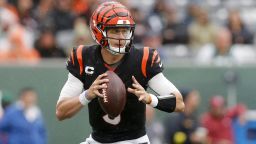The National Football League and the NFL Players Association agreed to update the league’s concussion protocol on Saturday.
The decision follows a review of the response to Miami Dolphins quarterback Tua Tagovailoa’s injury on September 25. Tagovailoa suffered an apparent head injury and was later allowed to reenter the game. Tagovailoa, 24, was later hospitalized for a concussion.
The league and union jointly announced the findings of the review on Saturday.
Under the new protocols, players will be unable to compete if they are experiencing ataxia, which describes a lack of coordination caused by poor muscle control.
The joint announcement described the conclusion and findings of their review of Tagovailoa’s injury as follows:
“While the investigation determined that the team medical staff and unaffiliated medical professionals followed the steps of the Protocol as written, the NFL and NFLPA agree that the outcome in this case is not what was intended when the Protocols were drafted.”
“As such, as has been done in previous cases, based on the advice of the parties’ respective medical experts, the Protocol will be modified to enhance the safety of the players. Specifically, the term ‘ataxia’ has been added to the mandatory ‘no-go’ symptoms. ‘Ataxia’ is defined as abnormality of balance/stability, motor coordination or dysfunctional speech caused by a neurological issue.
“In other words, if a player is diagnosed with ‘ataxia’ by any club or neutral physician involved in the application of the Concussion Protocol, he will be prohibited from returning to the game, and will receive the follow-up care required by the Protocol.”
Dr. Allen Sills, the NFL’s chief medical officer, said during a Saturday news conference with the new concussion protocols, Tagovailoa would have been ruled out for the rest of the game against the Buffalo Bills on September 25 because ataxia was present in the player’s case.
Sills did not rule out Tagovailoa suffering a concussion during the game, but said the Dolphins followed the existing concussion protocols, and Tagovailoa did not display concussion symptoms while being evaluated in the locker room and in the days after.
With the change in protocols, Sills mentioned the NFL will take a “conservative” approach to ruling players out. He acknowledged players who might not have suffered a brain injury might still be ruled out anyway, if ataxia is present.
“… let’s just go ahead and assume it is coming from the brain and we will hold someone out,” Sills said. “Because if we are going to be wrong, we would rather hold someone out who doesn’t have a brain injury but we are being cautious, than to put someone out who might have a brain injury and we weren’t able to diagnose it.”
In a game against the Buffalo Bills on September 25, the 24-year-old quarterback was knocked down and banged his head on the turf. When he stood up, he shook his head, appeared awkward on his feet and stumbled over himself.
He was taken to the locker room for a concussion check, and the Dolphins announced he was questionable to return with a head injury. However, he returned to play after halftime and finished the game.
His return was noteworthy because the NFL’s current concussion protocols state a player who shows any “gross motor instability” determined to be neurologically caused cannot return to the game.
After the game, Tagovailoa told reporters he actually stumbled because of a back injury – not a head injury – and he was evaluated for a concussion but cleared. Head coach Mike McDaniel told reporters Tagovailoa’s back got “bent” on an earlier play, causing his back to lock up.
Despite assurances it was a back injury, the NFL Players Association initiated a review into the handling of his injury.
Just four days later, in a prime-time game on September 29, Tagovailoa was slammed to the ground by Cincinnati Bengals defensive lineman Josh Tupou. The quarterback’s arms and fingers immediately contorted into a gruesome position known as the “fencing response,” a sign of brain injury, and he lay motionless on the field for several minutes.
He was ultimately placed on a backboard and stretcher and taken to a hospital, where he was diagnosed with a concussion.
The disturbing injury and questions around why he was allowed to play has led to criticisms and scrutiny inside and outside the league. Baltimore Ravens head coach John Harbaugh called the events “astonishing” while players association president JC Tretter said he was “outraged” at what happened.
The NFL and the players’ association released their statement agreeing to update the concussion protocol in tandem. Additionally, as part of the investigation, a source confirmed to CNN, the unaffiliated neurotrauma consultant involved in clearing the quarterback during the Bills game was let go by the players’ union, a move first reported by ESPN. The source added the Dolphins’ team physician is being questioned as part of the investigation.
CNN’s Nadia Kounang and Ben Morse contributed to this report.





